
Geneva Public Transport operates most of the public transportation system in canton of Geneva, Switzerland, including the city of Geneva. The agency's head office is in Grand-Lancy, Lancy.

An articulated bus, also referred to as a slinky bus, bendy bus, tandem bus, vestibule bus, stretch bus, or an accordion bus, is an articulated vehicle, typically a motor bus or trolleybus, used in public transportation. It is usually a single-decker, and comprises two or more rigid sections linked by a pivoting joint (articulation) enclosed by protective bellows inside and outside and a cover plate on the floor. This allows a longer legal length than rigid-bodied buses, and hence a higher passenger capacity (94–120), while still allowing the bus to maneuver adequately.
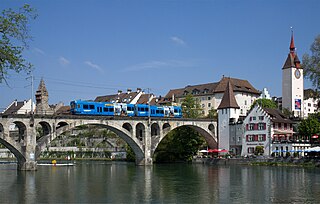
The Wohlen–Dietikon railway line is a railway line in Switzerland. It connects Wohlen and Bremgarten in the canton of Aargau with Dietikon in the canton of Zürich. Passenger service on the line now forms part of the Zürich S-Bahn, branded as the S17, and a frequent service is provided, with trains running up to every 15 minutes.
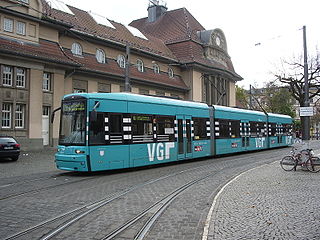
The Bombardier Flexity Classic is a model of light-rail tram manufactured by Bombardier Transportation. Although it is marketed as the most traditionally designed member of the Flexity family, it is still a modern bi-directional articulated tram with a low-floor section allowing good accessibility, especially to passengers in wheelchairs. Flexity Classic trams run on 1,435 mmstandard gauge in Australia, 1,000 mmmetre gauge in Essen, 1,450 mm in Dresden, and 1,458 mm in Leipzig.
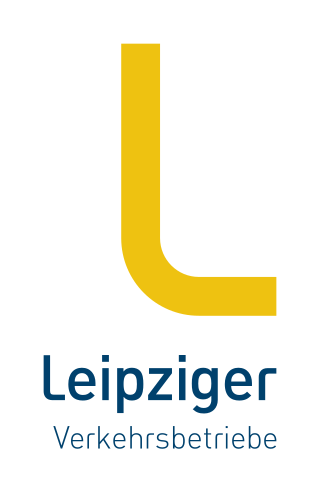
The Leipziger Verkehrsbetriebe (LVB), literally translated into English as the Leipzig Transport Authority, operates the tramway and bus transport services in Leipzig, Germany. The LVB network is a part of the regional public transport association, the Mitteldeutscher Verkehrsverbund (MDV). The LVB was formed by the merger, from 1 January 1917, of two predecessor undertakings, the Großen Leipziger Straßenbahn and the Leipziger Elektrischen Straßenbahn. The merged undertaking was also known as GLSt until it was reorganized and renamed as the LVB, from 29 July 1938.
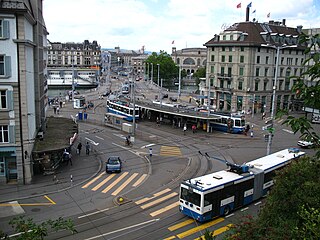
Verkehrsbetriebe Zürich (VBZ) is a public transport operator in the Swiss city of Zurich, and is wholly owned by the city. Previously known as the Städtische Strassenbahn Zürich (StStZ), the organisation was founded in 1896 and adopted its current name in 1950.
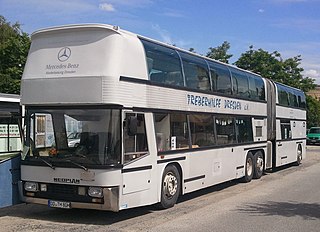
The Neoplan Jumbocruiser was an articulated double-deck multi-axle city coach built by Neoplan Bus GmbH between 1975 and 1992. At 18 metres (59 ft) in length, 2.5 m wide and 4 m (13 ft) in height, it has a capacity for 170 passengers.

The Saint-Étienne tramway is a tram system in the city of Saint-Étienne in the Rhône-Alpes (France) that has functioned continuously since its opening in 1881. The first tramway line was steam-operated and was opened by the Chemins de Fer à Voie étroite de Saint-Étienne (CFVE) on 4 December 1881, stretching for 5.5 km between La Terrasse and Bellevue. The CFVE took over the Compagnie des Tramways Électriques de Saint-Étienne lines and discontinued the use of steam in 1912.

A battery electric bus is an electric bus that is driven by an electric motor and obtains energy from on-board batteries. Many trolleybuses use batteries as an auxiliary or emergency power source.

A bi-articulated bus or double-articulated bus and sometimes train-bus, tram-bus, trackless tram or double bendy bus is a type of high-capacity articulated bus with an extra axle and a second articulation joint, as well as extended length. Bi-articulated buses tend to be employed in high-frequency core routes or bus rapid transit schemes rather than in conventional bus routes.
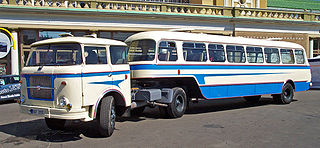
A trailer bus is a trailer vehicle designed specifically for the transportation of passengers. Trailer buses typically comprise one of two forms:

Dresdner Verkehrsbetriebe AG (DVB) is the municipal transport company of the city of Dresden in Germany. It is a member of the Verkehrsverbund Oberelbe transport association that manages a common public transport structure for Dresden and its surrounding areas. The DVB operates the Dresden tram network comprising 12 tram lines, with a total line length of approximately 210 kilometres (130.5 mi) and a total route length of 132.7 kilometres (82.5 mi), and 28 bus lines, with a total line length of approximately 306 kilometres (190.1 mi). It is also responsible for two funicular railways and three ferries across the River Elbe.
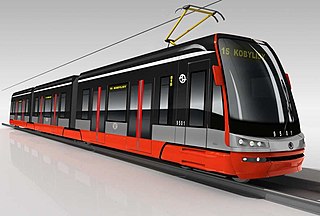
Škoda 15T is a 100% low-floor multiple-unit tram developed by VUKV a.s. and built by Škoda Transportation in Pilsen for the Prague tram network. It was a successor to the Škoda 14 T, featuring articulated bogies and more power to correct for problems found during the operation of the 14 T. The 15T has articulated bogies at either end of the train, and Jacobs bogies between the segments. The tram has two double-doors in each segment to allow fast boarding of passengers, and one extra side door leading to the driver's cabin.

The Munich tramway is the tramway network for the city of Munich in Germany. Today it is operated by the municipally owned Münchner Verkehrsgesellschaft and is known officially and colloquially as the Tram. Previous operators have included Société Anonyme des Tramways de Munich, the Münchner Trambahn-Aktiengesellschaft, the Städtische Straßenbahnen and the Straßenbahn München.

The Green Mover Max was the first 100% low-floor articulated Light Rail Vehicle (LRV) to be built entirely in Japan. It was developed jointly by Kinki Sharyo, Mitsubishi Heavy Industries, and Toyo Denki, and introduced first in Hiroshima by the Hiroshima Electric Railway Company (Hiroden). It replaced Hiroden's ailing fleet of Siemens Combinos in 2005.

The St. Gallen trolleybus system forms part of the public transport network of St. Gallen, the capital city of the canton of St. Gallen, Switzerland.
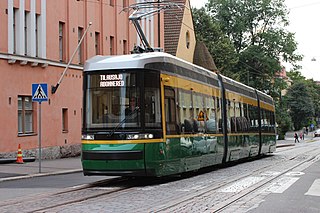
Artic, styled as ARTIC or ForCity Smart, is an articulated low-floor tram model designed and manufactured by Škoda Transtech Oy in Finland. Trams of the design are in operation in Finland, Germany and Czechia, with further large orders in these countries. The design was subsequently rebranded under the Škoda ForCity brand.

The Halberstadt tramway network is a network of tramways forming part of the public transport system in Halberstadt, a city in the federal state of Saxony-Anhalt, Germany.
The Volvo Gran Artic 300 is a proposed bi-articulated bus chassis manufactured by Volvo. It was developed in Brazil to operate on bus rapid transit systems. At 30 metres, it will be the longest bus in the world and be able to carry 300 passengers. It was launched in November 2016.
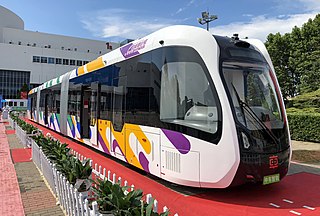
Autonomous Rail Rapid Transit (ART) is a lidar guided bus and bi-articulated bus system for urban passenger transport. Developed and manufactured by CRRC through CRRC Zhuzhou Institute Co Ltd, it was unveiled in Zhuzhou in the Hunan province on June 2, 2017. ART is specifically referred to as a train or rapid transit as Digital-rail Rapid Transit by its manufacturer, however the public describes it as a bus. Its exterior is composed of individual fixed sections joined by articulated gangways, resembling a rubber-tyred tram and translohr.



















